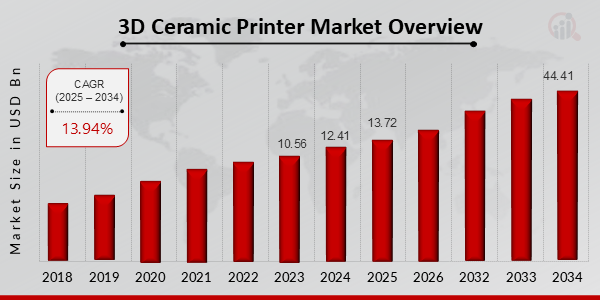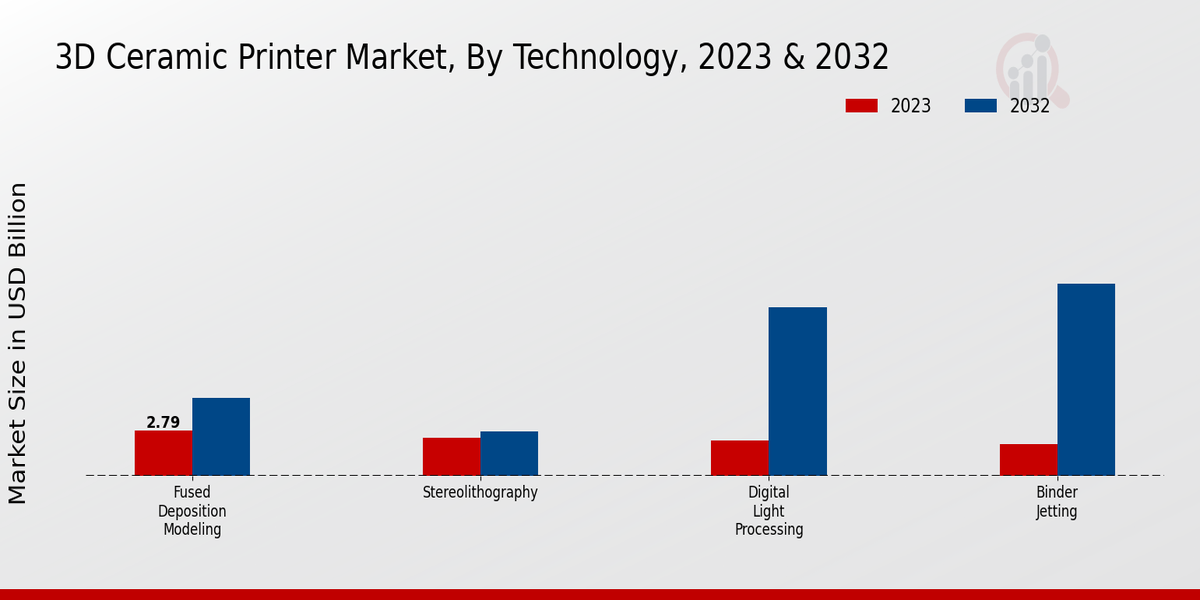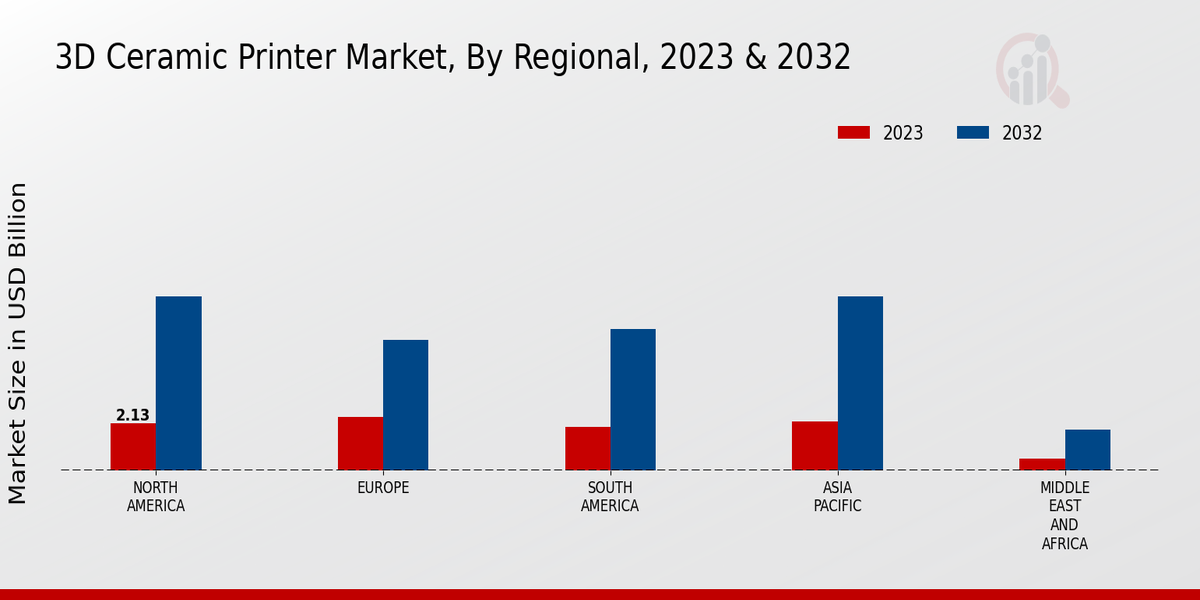3D Ceramic Printer Market Overview
3D Ceramic Printer Market is projected to grow from USD 13.72 Billion in 2025 to USD 44.41 Billion by 2034, exhibiting a compound annual growth rate (CAGR) of 13.94% during the forecast period (2025 - 2034). Additionally, the market size for 3D Ceramic Printer Market was valued at USD 12.41 billion in 2024.
Key 3D Ceramic Printer Market Trends Highlighted
Advanced manufacturing techniques and the demand for customized products are driving the growth of the 3D ceramic printer market.The ability of these printers to produce complex and detailed ceramic objects has made them attractive for applications in aerospace, medical, and automotive industries.The rise of digital dentistry and the increasing use of ceramics in dental implants and prosthetics are also contributing to market growth.Growing government support for 3D printing technologies and increased investment in research and development are creating new opportunities for market expansion.
The development of novel ceramic materials and printing techniques is expected to further enhance the capabilities of these printers, opening new applications in industries such as electronics and energy.The trend towards automation and digitization in manufacturing is driving the adoption of 3D ceramic printers. These printers enable increased production efficiency, reduce lead times, and improve product quality.Advancements in software and materials are also making 3D ceramic printing more accessible and affordable for a wider range of users, including small businesses and hobbyists.
Figure 1 3D Ceramic Printer Market Overview ( 2025-2034 )

Source: Primary Research, Secondary Research, Market Research Future Database and Analyst Review
3D Ceramic Printer Market Drivers
Rising Demand for Customized Ceramics
The growing demand for customized ceramics in various industries, such as aerospace, healthcare, and automotive, is a significant driver of the 3D Ceramic Printer Market.3D ceramic printing enables the production of complex and intricate ceramic components with high precision and accuracy, meeting the specific requirements of these industries.The ability to create customized ceramic parts with unique shapes, sizes, and properties opens new possibilities for innovation and product development, contributing to the market's growth.
Advancements in 3D Ceramic Printing Technology
Technological advancements in 3D ceramic printing are propelling the market forward. Innovations in materials, printing techniques, and software are enhancing the capabilities and efficiency of 3D ceramic printers.The development of new ceramic materials with improved properties, such as higher strength, thermal stability, and biocompatibility, is expanding the applications of 3D ceramic printing.Additionally, advancements in printing techniques, including multi-material printing and high-resolution printing, are enabling the production of complex and detailed ceramic parts.
Expanding Applications in Diverse Industries
The 3D ceramic printing market is being driven by a growing array of applications across a wide variety of industries. In addition to its traditional use of prototyping and manufacturing, 3D ceramic printing is also used in such diverse fields as healthcare and dentistry as well as jewelry making.In the field of healthcare, it is used to create patient-specific implants, surgical guides, and tissue scaffolds.
In addition, it is also used in dentistry to produce custom dental prosthetics, such as crowns, bridges, and dentures.The market is growing as diverse applications may benefit from the versatility and applicability of 3D ceramic printing.
3D Ceramic Printer Market Segment Insights
3D Ceramic Printer Market Technology Insights
The 3D Ceramic Printer Market is categorized by four technologies, that is, Fused Deposition modeling (FDM), Stereolithography, Digital Light Processing, and Binder Jetting.FDM technology, which is also the largest market share for the year 2023, is anticipated to grow at a CAGR of 14.2%, hence reaching a valuation of USD 11.25 billion by 2032.Due to the increasing application of this technology by several industries, such as aerospace, automotive, and health care, it is expected to surge significantly.
SLA technology, which is one of the important segments in the 3D Ceramic Printer Market, is also projected to rise.It is expected to grow at a CAGR of 13.6% hence reaching a valuation of USD 9.5 billion by 2032. Notably, SLA printers are more accurate and possess higher resolution, qualities suitable for the dental, jewelry, and medical device industries.In addition, DLP technology is another technology in the 3D ceramic printer market, and it is bound to grow. It is anticipated to rise at a CAGR of 13.4%, thus reaching a valuation of USD 8.7 billion by 2032.
DLP printers' quality is that they are fast, print speed, and material cost-effective compared to other technologies.On the other hand, the other technology, that is, the Binder Jetting technology, which has a small market share, is expected to surge. It will grow at a CAGR of 12.8% hence reaching a valuation of USD 7.9 billion by 2032.The growth is occasioned by the increasing demand for binder jetting technology to produce ceramic parts such as automotive and construction.
Figure 2 3D Ceramic Printer Market By Type ( 2023-2032 )

Source: Primary Research, Secondary Research, Market Research Future Database and Analyst Review
3D Ceramic Printer Market Material Insights
The Material segment of the 3D Ceramic Printer Market is segmented into Alumina, Zirconia, Hydroxyapatite and Titanium Dioxide. Alumina is expected to dominate the market in the coming years due to its high strength, hardness, and wear resistance.Zirconia is another popular material used in 3D ceramic printing due to its excellent mechanical properties and biocompatibility.Hydroxyapatite is a calcium phosphate ceramic that is used in medical applications due to its ability to bond with living tissue.
Titanium Dioxide is a versatile material that is used in a variety of applications, including 3D ceramic printing.The 3D Ceramic Printer Market is expected to grow significantly in the coming years, driven by the increasing demand for customized and high-performance ceramics in various industries.
3D Ceramic Printer Market Application Insights
The 3D Ceramic Printer Market is segmented by Application into Dental, Medical, Aerospace, and Industrial. Dental applications accounted for the largest share of the market in 2023 and are expected to continue to grow at a CAGR of 12.5% through 2032.This growth is being driven by the increasing demand for dental implants and other ceramic prosthetics.
Medical applications are also expected to experience significant growth, with a CAGR of 11.5% over the forecast period.This growth is being driven by the increasing use of 3D ceramic printing in the production of medical devices and implants.Aerospace and industrial applications are also expected to experience growth, with CAGRs of 10.5% and 10.0%, respectively.
3D Ceramic Printer Market End-Use Insights
The 3D Ceramic Printer Market is segmented based on end-use into manufacturers, R institutions, and hospitals.
The manufacturers segment accounted for the largest share of the 3D Ceramic Printer Market in 2023 and is projected to continue to dominate the market throughout the forecast period.The growth of this segment can be attributed to the increasing adoption of 3D ceramic printing technology by manufacturers for prototyping, tooling, and production of end-use parts.The research institutions segment is expected to witness significant growth during the forecast period due to the increasing use of 3D ceramic printing for research and development activities in various fields, such as biomedical engineering, materials science, and aerospace.The hospital segment is also expected to experience steady growth as 3D ceramic printing technology finds applications in medical device manufacturing, surgical planning, and patient-specific implants.
3D Ceramic Printer Market Regional Insights
The 3D Ceramic Printer Market is segmented into North America, Europe, APAC, South America, and MEA. North America held the largest market share in 2023 and is expected to maintain its dominance throughout the forecast period.The growth in this region can be attributed to the presence of major players in the 3D ceramic printing industry, such as Stratasys and 3D Systems.
Additionally, the increasing adoption of 3D printing technology in various industries, such as aerospace, automotive, and healthcare, is driving the growth of the 3D ceramic printer market in North America.Europe is the second-largest market for 3D ceramic printers, followed by APAC.
The growth in Europe is driven by the increasing demand for 3D-printed ceramic parts in the automotive and aerospace industries.The APAC region is expected to witness significant growth in the coming years due to the growing demand for 3D ceramic printers in countries such as China and India.The growth of the market is driven by the increasing adoption of 3D printing technology in various industries, as well as the growing demand for 3D printed ceramic parts.
Figure 3, 3D Ceramic Printer Market By Regional Insights ( 2023-2032 )

Source: Primary Research, Secondary Research, Market Research Future Database and Analyst Review
3D Ceramic Printer Market Key Players and Competitive Insights
Technology breakthroughs and innovations drive the development of the 3D ceramic printer market; an increasing number of the leading players in the industry step up focused efforts in technology and research investment to catch onto the evolving demand and the innovation opportunities that it entails ahead of its competitors.To achieve this, leading players have also doubled down on research and partnered with other companies to extend their product portfolios and diversify their positions around the globe.
The 3D ceramic printer market is a highly competitive one, with a substantial number of players, both established and recent.Competition across the 3D ceramic printer market is marked by a growing rivalry between larger global organizations and smaller regional ones. Such leading players in the 3D ceramic printers’ market are 3D Systems, Stratasys, Voxeljet, ExOne, and Desktop Metal. The companies range their product portfolios from entry-level to advanced 3D ceramic printers across the globe.
Growing demand across industries, such as aerospace, automotive, and healthcare, sustain the rapid expansion of the 3D Ceramic Printer Market.For instance, 3D Systems is dedicated to enriching and broadening its competitive offerings by expanding its existence into more than 30 countries, using its 3D ceramic printers in aerospace, automotive, and healthcare via research innovations.3D Systems is a leading company in the 3D printing discipline known worldwide for its 3D ceramic printers.
The company’s 3D ceramic printers exist in many forms, from benchtops to the generation range of big systems like the automotive, aerospace, and health industries.3D Systems has a presence in over 30 countries, driving innovation in 3D ceramic printer R with its team that continues to grow by the day. Another such company is Voxeljet, another important player among providers of 3D ceramic printers.Voxeljet operates all over the globe, with its operations spanning over 20 countries.
They have 3D ceramic printers in a variety of forms, such as small ones for your desktop to large ones such as industrial systems.Voxeljet, just like 3D Systems, segments its operations across the automotive, health care, and aerospace industries through innovation in R investments.
Key Companies in the 3D Ceramic Printer Market Include
3D Ceramic Printer Market Developments
-
Q2 2024: Ceramics 3D Printing Market to Hit Nearly $1B by 2033 - 3DPrint.com Additive Manufacturing (AM) Research launched a new product line focused on ceramics 3D printing market data, including detailed vendor, hardware, and application breakdowns, marking a significant expansion in industry-specific market intelligence offerings.
3D Ceramic Printer Market Segmentation Insights
-
3D Ceramic Printer Market Technology Outlook
- Fused Deposition Modeling (FDM)
Stereolithography (SLA)
Digital Light Processing (DLP)
Binder Jetting
-
3D Ceramic Printer Market Material Outlook
- Alumina
Zirconia
Hydroxyapatite
Titanium Dioxide
-
3D Ceramic Printer Market Application Outlook
- Dental
Medical
Aerospace
Industrial
-
3D Ceramic Printer Market End-Use Outlook
- Manufacturers
RD Institutions
Hospitals
-
3D Ceramic Printer Market Regional Outlook
-
North America
Europe
South America
Asia Pacific
Middle East and Africa
|
Report Attribute/Metric
|
Details
|
|
Market Size 2024
|
12.41 (USD Billion)
|
|
Market Size 2025
|
13.72 (USD Billion)
|
|
Market Size 2034
|
44.41 (USD Billion)
|
|
Compound Annual Growth Rate (CAGR)
|
13.94% (2025 - 2034)
|
|
Report Coverage
|
Revenue Forecast, Competitive Landscape, Growth Factors, and Trends
|
|
Base Year
|
2024
|
|
Market Forecast Period
|
2025 - 2034
|
|
Historical Data
|
2019 - 2023
|
|
Market Forecast Units
|
USD Billion
|
|
Key Companies Profiled
|
Lix3D, Amatec, 3D Systems, Xometry, Prodways, Aryon Ceramics, Lithoz, ExOne, XJet, voxeljet, CeraPrinters, Stratasys, Kitware
|
|
Segments Covered
|
Technology, Material, Application, End-Use, Regional
|
|
Key Market Opportunities
|
Increased demand for customized ceramics Advancements in material science Expansion of healthcare and aerospace industries Rising adoption in the automotive sector Government initiatives for innovation
|
|
Key Market Dynamics
|
Growth of the construction sector, increasing demand for customized ceramics, technological advancements, government initiatives for the manufacturing sector, and rising adoption of healthcare
|
|
Countries Covered
|
North America, Europe, APAC, South America, MEA
|
Frequently Asked Questions (FAQ):
The 3D Ceramic Printer Market size was valued at USD 12.41 billion in 2024 and is expected to grow at a compound annual growth rate (CAGR) of 13.94% from 2025 to 2034, reaching an estimated value of USD 44.41 billion by 2034.
The key regions in the 3D Ceramic Printer Market are North America, Europe, Asia-Pacific, and the Rest of the World. Among these, North America is expected to hold the largest market share during the forecast period, followed by Europe and Asia-Pacific.
Major applications of 3D ceramic printers include prototyping, manufacturing, dental, medical, and jewelry. Prototyping is the most common application, accounting for a significant share of the market.
Key competitors in the 3D Ceramic Printer Market include 3D Systems, Stratasys, ExOne, Voxeljet, and Desktop Metal. These companies offer a wide range of 3D ceramic printers and materials, and they have a strong presence in various regions.
The 3D Ceramic Printer Market faces several challenges, including the high cost of 3D ceramic printers and materials, the limited availability of skilled labor, and the lack of standardization in the industry. However, the growing demand for customized products and the increasing adoption of 3D printing in various industries are expected to drive market growth.
Opportunities for growth in the 3D Ceramic Printer Market include the increasing adoption of 3D printing in various industries, such as healthcare, automotive, and aerospace. Additionally, the development of new materials and technologies is expected to expand the applications of 3D ceramic printers.
Key trends in the 3D Ceramic Printer Market include the increasing demand for customized products, the growing adoption of 3D printing in various industries, and the development of new materials and technologies. Additionally, the emergence of new business models, such as 3D printing-as-a-service, is expected to drive the market growth.
COVID-19 had a significant impact on the 3D Ceramic Printer Market in the short term. However, the long-term impact is expected to be positive as the demand for customized products and the adoption of 3D printing in various industries is expected to increase.
Key drivers of growth in the 3D Ceramic Printer Market include the increasing demand for customized products, the growing adoption of 3D printing in various industries, and the development of new materials and technologies.
Key restraints in the 3D Ceramic Printer Market include the high cost of 3D ceramic printers and materials, the limited availability of skilled labor, and the lack of standardization in the industry.

















